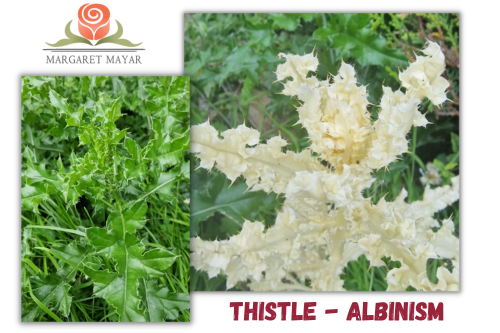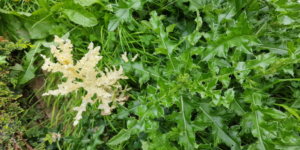
I found something that combines plant biology with human medicine – plant albinism, also known as plant leukosis. As in the case of humans, albinism in plants causes a complete or partial lack of pigmentation, which leads to the disappearance of the green pigment – chlorophyll – in chloroplasts. This is a fascinating phenomenon that deserves our attention and understanding.

Plant albinism is a genetic aberration that causes no or limited production of chlorophyll in plant leaves. Like leukemia in humans, plant leukemia is a condition that causes the loss of the natural pigment – chlorophyll – in the chloroplasts of plants. Chlorophyll is essential for the process of photosynthesis, where plants convert sunlight into energy. When this green pigment disappears, the plants turn white or pale, which is clearly visible in their leaves or other parts of the plant.
While it is difficult to find a plant with leukemia in nature, in cultivation you can often find potted plants whose decorative element are white spots on the leaves. The best example is the popular Monstera Variegata. The plant has a specific beauty, but requires a little more care. It needs much more light than typical plants.
Unless we are now looking at cultivated plants whose advantage is partially white leaves, in cultivated plants there is no effective way to treat albinism in plants. However, there are some steps we can take to minimize its negative effects. For agricultural crops, selecting varieties that are resistant to albinism can help reduce crop losses. Additionally, ensuring optimal environmental conditions and regular fertilization can help maintain plant health.
Plant leukemia, like human leukemia, is a complex phenomenon that requires further research and understanding. However, despite its rarity, it is an extraordinary source of information about the functioning of plants and their response to changes in the environment. Therefore, research on plant leukemia is important not only for science, but also for the conservation and understanding of the diversity of plant life on Earth. Therefore, I encourage you to further explore this fascinating topic and observe nature in its extraordinary diversity.
What do you think about plant albinism? Have you encountered this phenomenon in your garden or farmland? Share your experiences! I invite you to discuss.
Znalazłam coś, co łączy biologię roślin z medycyną człowieka – bielactwo roślinne, zwane także białaczką roślinną. Podobnie jak u ludzi, bielactwo u roślin powoduje całkowity lub częściowy brak pigmentacji, co prowadzi do zaniku zielonego pigmentu – chlorofilu – w chloroplastach. To fascynujące zjawisko, które zasługuje na naszą uwagę i zrozumienie.

Bielactwo roślin to aberracja genetyczna, która powoduje brak lub ograniczoną produkcję chlorofilu w liściach roślin. Podobnie jak białaczka u ludzi, białaczka roślinna jest stanem powodującym utratę naturalnego pigmentu – chlorofilu – w chloroplastach roślin. Chlorofil jest niezbędny w procesie fotosyntezy, podczas którego rośliny przekształcają światło słoneczne w energię. Kiedy ten zielony pigment zaniknie, rośliny stają się białe lub blade, co jest wyraźnie widoczne na ich liściach lub innych częściach rośliny.
O ile w przyrodzie trudno znaleźć roślinę chorą na białaczkę, o tyle w uprawie często można spotkać rośliny doniczkowe, których elementem dekoracyjnym są białe plamki na liściach. Najlepszym przykładem jest popularna Monstera Variegata. Roślina ma specyficzną urodę, wymaga jednak nieco większej pielęgnacji. Potrzebuje znacznie więcej światła niż typowe rośliny.
O ile nie przyjrzymy się teraz roślinom uprawnym, których zaletą są częściowo białe liście, w przypadku roślin uprawnych nie ma skutecznego sposobu leczenia bielactwa u roślin. Istnieje jednak kilka kroków, które możemy podjąć, aby zminimalizować jego negatywne skutki. W przypadku upraw rolnych wybór odmian odpornych na bielactwo może pomóc w zmniejszeniu strat w plonach. Dodatkowo zapewnienie optymalnych warunków środowiskowych i regularne nawożenie mogą pomóc w utrzymaniu zdrowia roślin.
Białaczka roślinna, podobnie jak białaczka ludzka, jest złożonym zjawiskiem wymagającym dalszych badań i zrozumienia. Jednak pomimo swojej rzadkości jest niezwykłym źródłem informacji o funkcjonowaniu roślin i ich reakcji na zmiany w środowisku. Dlatego badania nad białaczką roślinną są ważne nie tylko dla nauki, ale także dla ochrony i zrozumienia różnorodności życia roślinnego na Ziemi. Dlatego zachęcam do dalszego zgłębiania tego fascynującego tematu i obserwowania natury w jej niezwykłej różnorodności.
Co sądzisz o albinizmie roślin? Czy spotkałeś się z tym zjawiskiem w swoim ogrodzie lub na polu uprawnym? Podziel się swoimi doświadczeniami! Zapraszam do dyskusji.
A very competent company. A wide range of knowledge and a wide range. I recommend it to all hobbyists, artists and gardeners.
Ordered 10+ Talia threads. They came in a couple of days with 2 free sample bottles of Mill cleaner (nice scent). 10/10
Amazing service and great quality products! Clearly has a great knowledge with gardening products with advice given. 100% would recommend.
Really impressed with the wide knowledge of garden products and the service was both high quality and timely. I would strongly recommend Margaret's services
Superb service and excellent products all delivered on time. Will be using this company again.
A very competent company. A wide range of knowledge and a wide range. I recommend it to all hobbyists, artists and gardeners.
Ordered 10+ Talia threads. They came in a couple of days with 2 free sample bottles of Mill cleaner (nice scent). 10/10
Amazing service and great quality products! Clearly has a great knowledge with gardening products with advice given. 100% would recommend.
Really impressed with the wide knowledge of garden products and the service was both high quality and timely. I would strongly recommend Margaret's services
Superb service and excellent products all delivered on time. Will be using this company again.